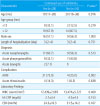1. Monto AS. Epidemiology of viral respiratory infections. Am J Med. 2002; 112:Suppl 6A. 4S–12S.

2. Fleming-Dutra KE, Hersh AL, Shapiro DJ, Bartoces M, Enns EA, File TM Jr, et al. Prevalence of inappropriate antibiotic prescriptions among US ambulatory care visits, 2010–2011. JAMA. 2016; 315:1864–1873.

3. Hersh AL, Shapiro DJ, Pavia AT, Shah SS. Antibiotic prescribing in ambulatory pediatrics in the United States. Pediatrics. 2011; 128:1053–1061.

4. Shin SM, Shin JY, Kim MH, Lee SH, Choi S, Park BJ. Prevalence of antibiotic use for pediatric acute upper respiratory tract infections in Korea. J Korean Med Sci. 2015; 30:617–624.

5. Grijalva CG, Nuorti JP, Griffin MR. Antibiotic prescription rates for acute respiratory tract infections in US ambulatory settings. JAMA. 2009; 302:758–766.

6. Mangione-Smith R, Wong L, Elliott MN, McDonald L, Roski J. Measuring the quality of antibiotic prescribing for upper respiratory infections and bronchitis in 5 US health plans. Arch Pediatr Adolesc Med. 2005; 159:751–757.

7. Hersh AL, Jackson MA, Hicks LA. American Academy of Pediatrics Committee on Infectious Diseases. Principles of judicious antibiotic prescribing for upper respiratory tract infections in pediatrics. Pediatrics. 2013; 132:1146–1154.

8. van de Pol AC, Wolfs TF, Tacke CE, Uiterwaal CS, Forster J, van Loon AM, et al. Impact of PCR for respiratory viruses on antibiotic use: theory and practice. Pediatr Pulmonol. 2011; 46:428–434.

9. Sharma V, Dowd MD, Slaughter AJ, Simon SD. Effect of rapid diagnosis of influenza virus type a on the emergency department management of febrile infants and toddlers. Arch Pediatr Adolesc Med. 2002; 156:41–43.

10. Byington CL, Castillo H, Gerber K, Daly JA, Brimley LA, Adams S, et al. The effect of rapid respiratory viral diagnostic testing on antibiotic use in a children's hospital. Arch Pediatr Adolesc Med. 2002; 156:1230–1234.

11. Doan QH, Kissoon N, Dobson S, Whitehouse S, Cochrane D, Schmidt B, et al. A randomized, controlled trial of the impact of early and rapid diagnosis of viral infections in children brought to an emergency department with febrile respiratory tract illnesses. J Pediatr. 2009; 154:91–95.

12. Krause JC, Panning M, Hengel H, Henneke P. The role of multiplex PCR in respiratory tract infections in children. Dtsch Arztebl Int. 2014; 111:639–645.

13. Pozzetto B, Grattard F, Pillet S. Multiplex PCR theranostics of severe respiratory infections. Expert Rev Anti Infect Ther. 2010; 8:251–253.

14. Wishaupt JO, Russcher A, Smeets LC, Versteegh FG, Hartwig NG. Clinical impact of RT-PCR for pediatric acute respiratory infections: a controlled clinical trial. Pediatrics. 2011; 128:e1113–e1120.

15. Chonmaitree T, Alvarez-Fernandez P, Jennings K, Trujillo R, Marom T, Loeffelholz MJ, et al. Symptomatic and asymptomatic respiratory viral infections in the first year of life: association with acute otitis media development. Clin Infect Dis. 2015; 60:1–9.

16. Stockmann C, Ampofo K, Hersh AL, Carleton ST, Korgenski K, Sheng X, et al. Seasonality of acute otitis media and the role of respiratory viral activity in children. Pediatr Infect Dis J. 2013; 32:314–319.

17. Health Insurance Review & Assessment Service. The results of appropriate antibiotics prescription in chilren with acuteotitis media 2013 [Internet]. Wonju: HIRA;c2013. cited 2017 Jun 10. Available from:
http://www.hira.or.kr.
18. Venekamp RP, Sanders SL, Glasziou PP, Del Mar CB, Rovers MM. Antibiotics for acute otitis media in children. Cochrane Database Syst Rev. 2015; (6):CD000219.

19. Lieberthal AS, Carroll AE, Chonmaitree T, Ganiats TG, Hoberman A, Jackson MA, et al. The diagnosis and management of acute otitis media. Pediatrics. 2013; 131:e964–e999.

20. Vouloumanou EK, Karageorgopoulos DE, Kazantzi MS, Kapaskelis AM, Falagas ME. Antibiotics versus placebo or watchful waiting for acute otitis media: a meta-analysis of randomized controlled trials. J Antimicrob Chemother. 2009; 64:16–24.

21. Kitamura K, Iino Y, Kamide Y, Kudo F, Nakayama T, Suzuki K, et al. Clinical practice guidelines for the diagnosis and management of acute otitis media (AOM) in children in Japan: 2013 update. Auris Nasus Larynx. 2015; 42:99–106.

22. Kalu SU, Ataya RS, McCormick DP, Patel JA, Revai K, Chonmaitree T. Clinical spectrum of acute otitis media complicating upper respiratory tract viral infection. Pediatr Infect Dis J. 2011; 30:95–99.

23. Uitti JM, Tahtinen PA, Laine MK, Ruohola A. Close follow-up in children with acute otitis media initially managed without antimicrobials. JAMA Pediatr. 2016; 170:1107–1108.

24. Toikka P, Irjala K, Juven T, Virkki R, Mertsola J, Leinonen M, et al. Serum procalcitonin, C-reactive protein and interleukin-6 for distinguishing bacterial and viral pneumonia in children. Pediatr Infect Dis J. 2000; 19:598–602.

25. Putto A, Ruuskanen O, Meurman O, Ekblad H, Korvenranta H, Mertsola J, et al. C reactive protein in the evaluation of febrile illness. Arch Dis Child. 1986; 61:24–29.

26. Huijskens EG, Biesmans RC, Buiting AG, Obihara CC, Rossen JW. Diagnostic value of respiratory virus detection in symptomatic children using real-time PCR. Virol J. 2012; 9:276.

27. van Woensel JB, van Aalderen WM, Kimpen JL. Viral lower respiratory tract infection in infants and young children. BMJ. 2003; 327:36–40.

28. Oosterheert JJ, van Loon AM, Schuurman R, Hoepelman AI, Hak E, Thijsen S, et al. Impact of rapid detection of viral and atypical bacterial pathogens by real-time polymerase chain reaction for patients with lower respiratory tract infection. Clin Infect Dis. 2005; 41:1438–1444.

29. Rhedin S, Lindstrand A, Rotzen-Ostlund M, Tolfvenstam T, Ohrmalm L, Rinder MR, et al. Clinical utility of PCR for common viruses in acute respiratory illness. Pediatrics. 2014; 133:e538–e545.








 PDF
PDF ePub
ePub Citation
Citation Print
Print




 XML Download
XML Download